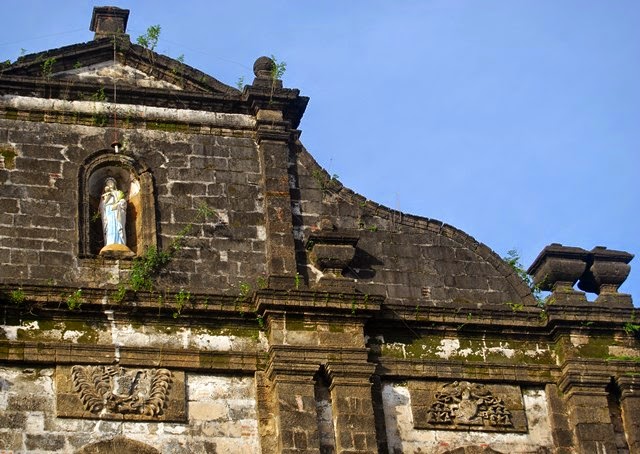The
progressive municipality of Santa Barbara has a colorful history which spans
from its early occupation by Spanish authorities. The Spanish culture has left its mark on the
historical sites of the town. There are excellent selections of historic sites
in the area and you can plan some other great things to see on your trips.
The
SANTA BARBARA CHURCH AND CONVENT is of Baroque-Renaissance architectural style.
The first church was built same time it became an independent parish in 1760.
It was destroyed during the 1787 earthquake. The present church was constructed
in 1849 under the supervision of Father Francisco Agueria and was continued by
Father Mateo Rodriguez from 1855 – 1873. It was continued and finished by
father Calixto Fernandez in 1878. The convent was built the same time as the
church by the same priests. It measured 63 meters in length and with a width of
19 meters. Materials used in the construction of the church and convent were of
adobe and coral stones quarried from Alimodian and were used for the flooring,
walls and posts. Materials transported to the town by carts drawn by carabaos.
Red bricks were also used. Connected to the side door of the church is its
L-shaped convent of Antillan architectural style. The ground floor of the convent
serves as the office of the church and its second floor serves as the quarters
of the priest. The church served as the headquarters for the Ilonggo
Revolutionary Forces in Western Visayas under General Martin Delgado in 1898.
It was untouched during World War II and had withstood the 1948 earthquake. It
was declared as a National Historical Landmark by the National Historical
Institute in 1990 and was given a marker in November 17, 2012.
The
ILOILO GOLF AND COUNTRY CLUB built in 1907, is one of the oldest golf courses
in Asia and the oldest existing golf course in the Philippines. It started as a
9-hole golf course that was carved from the rolling hills of Barangay San
Sebastian by a group expatriates from Scotland, England and America who were in
Iloilo to work for the Panay Railways. It was the first Philippine club
accepted as an affiliate of The Royal and Ancient Golf Club of St Andrews in
Scotland. It was only in the year 1920 when Filipinos were allowed to join the
elite club. Prior to 1947, it was known as Santa Barbara Golf and Country Club.
Today, this 35-hectare historic recreation area is a challenging 18-hole golf
course. The old clubhouse holds a mini- museum where old golf balls and other
golf paraphernalia are on display. Getting there from the Iloilo International
Airport in Cabatuan is a 5-minuter drive or can be reached from the city by a
30- minuter ride.
The
MUNICIPAL BANDSTAND constructed in 1925 is the historic centerpiece of the
present Victory Plaza was the venue for various local gatherings of the people.
The ROMAN CATHOLIC CEMETRY built in 1845 is of Neo-Classical architectural design. Local hero Gen. Martin T. Deldago was buried there.
MARKER OF CRY OF SANTA BARBARA situated near the municipal football field was the site where the Philippine Flag was first raised outside of Luzon. CATMON TREE planted beside the municipal hall, the only one surviving in the area, is another historic symbol of the town. When Spanish authorities first arrived in the town they noticed this tree growing abundantly in the area. Thus, they named the town Catmon.
The ROMAN CATHOLIC CEMETRY built in 1845 is of Neo-Classical architectural design. Local hero Gen. Martin T. Deldago was buried there.
MARKER OF CRY OF SANTA BARBARA situated near the municipal football field was the site where the Philippine Flag was first raised outside of Luzon. CATMON TREE planted beside the municipal hall, the only one surviving in the area, is another historic symbol of the town. When Spanish authorities first arrived in the town they noticed this tree growing abundantly in the area. Thus, they named the town Catmon.
Visitors
can know more history of the town by dropping by the SANTA BARBARA CENTENNIAL
MUSEUM which houses the town’s proud historical heritage with interesting
antique artifacts, photos and personal belongings of local hero, Gen. Martin Delgado.
It was constructed in 1998 as part of the Centennial Freedom Trail Site Project
of the Philippine Centennial Commission. It also serves as the Tourist
Information Center of the town. It is situated beside the municipal hall
fronting the church and convent.
Today,
there are more than historic sites in Santa Barbara. You can plan some great
things to see and do on your trip. To know more about the town, visit their
booth at the fountain area on September 18-20 for the 10th TUMANDOK
celebration. For more information, please contact Mrs. Irene Magallon -
Municipal Tourism Officer at 09209697130
The
municipality of Santa Barbara is 15.6 kilometers away from the city. It is
politically subdivided into 60 barangays distributed over its 7,748 hectare
land area populated by 55,472 residents (2010 Census on Poluation). It annually
celebrates its Religious Fiesta every 4th of December. Market day is every
Friday. To get to Sta. Barbara, one can take a jeepney at the terminal fronting
Christ the King Memorial Park in Jaro, Iloilo City.










No comments:
Post a Comment